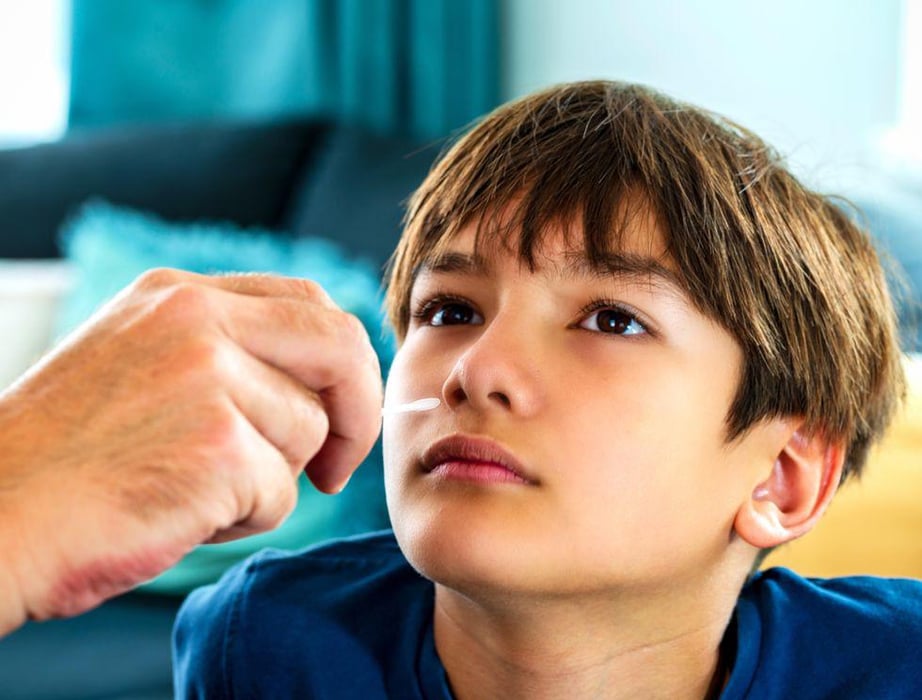At-Home COVID Tests Accurate for Kids: Study

TUESDAY, Jan. 18, 2022 (HealthDay News) -- Despite earlier concerns that at-home COVID-19 tests might be less accurate than PCR tests, new research in U.S. children and teens adds to evidence that the rapid tests are highly accurate.
The scientists said the accuracy of the tests — which can be used at home and in schools and provide quick results — is similar to that of PCR tests, which have to be analyzed in a lab and can take one to two days to deliver results.
The study included more than 1,000 children and teens, 17 and younger, who were tested at the Baltimore Convention Center Field Hospital (BCCFH) testing site during a seven-month period in 2021.
The participants were tested using the BinaxNOW rapid antigen test manufactured by Abbott Laboratories, a test that was recently shown to be highly accurate in adults. The tests were provided free of charge to the researchers by the Maryland Department of Health.
The rapid antigen test sensitivity rate (ability to identify people for whom the PCR test would detect infection) was 92.7%, and its specificity rate (ability to identify people for whom the PCR test would not detect infection) was 98%.
The sensitivity was similar for those with symptoms (92.3%) and without symptoms (92.6%).
The study also found that the negative predictive value (the probability that a person who tests negative has not been infected, as a PCR test would show) was high for both symptomatic (99.2%) and asymptomatic (99.7%) children and teens.
The findings were posted online recently on the preprint website MedRxiv and have not been peer-reviewed.
The results suggest that rapid COVID-19 testing can be confidently used to screen for children and teens who are infected but not showing symptoms, according to the researchers.
They said such testing could help keep classrooms safer.
"Quick, accurate and accessible diagnostic testing for SARS-CoV-2 in pediatric populations is critical to keeping children in classrooms, especially given the contagiousness of the newer virus variants, including Delta and Omicron," said study senior author Dr. Zishan Siddiqui, an assistant professor of medicine at Johns Hopkins University School of Medicine, in Baltimore.
"Our research — conducted when the Delta variant predominated — provides a timelier measure of the rapid antigen test's accuracy in children than studies done before the more transmissible variants became prevalent," Siddiqui added in a Hopkins news release.
The rapid tests offer a number of advantages over the PCR test, including taking less time to collect samples and process them, cost savings, and ease of distribution and use, Siddiqui noted.
This means they can help overcome COVID-19 testing disparities for children and teens in medically underserved communities, according to Siddiqui.
Study co-lead author Mary Jane Vaeth said, "Our findings of near 100% NPVs [negative predictive value] for both symptomatic and asymptomatic children and adolescents should pave the way for parents and school administrators to place more trust in the rapid antigen test results." Vaeth is a clinical assistant at the BCCFH.
And, study co-lead author Kristie Sun, a medical student at the Case Western Reserve University School of Medicine and a public health graduate from Johns Hopkins, added, "In turn, we hope that these results can inform educators in developing appropriate testing procedures to keep children in school."
More information
For more on COVID-19 tests, go to the U.S. Centers for Disease Control and Prevention.
SOURCE: Johns Hopkins University School of Medicine, news release, Jan. 14, 2022
Related Posts
¿Cómo afrontan las personas la pérdida del olfato y el gusto tras la COVID?
MIÉRCOLES, 27 de octubre de 2021 (HealthDay News) -- Las personas que han...
USPSTF Recommends Folic Acid Supplement Before, During Pregnancy
TUESDAY, Aug. 1, 2023 (HealthDay News) -- The U.S Preventive Services Task Force...
Adult Literacy, Active Mental Activities Lower Dementia Risk
FRIDAY, July 14, 2023 (HealthDay News) -- Engagement in adult literacy and...
